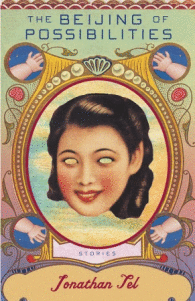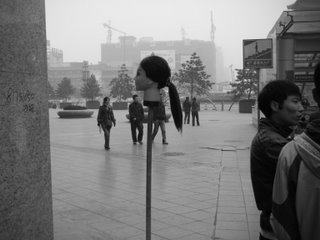 Let me tell you my favorite part of creating The Beijing of Possibilities. It was all rewarding --- the time I spent living and traveling in China, the research, the actual writing --- but what I enjoyed most was taking photographs to accompany the text. I made a special trip to Beijing in order to do this. The idea is to give the readers a bonus --- not just fiction set in China, but pictures of it too.
Let me tell you my favorite part of creating The Beijing of Possibilities. It was all rewarding --- the time I spent living and traveling in China, the research, the actual writing --- but what I enjoyed most was taking photographs to accompany the text. I made a special trip to Beijing in order to do this. The idea is to give the readers a bonus --- not just fiction set in China, but pictures of it too.Photography is an art that appeals to me, but I'm no expert. I made certain decisions: I'd use an inexpensive digital camera; I'd photograph what presented itself to me, not posing or orchestrating the scene, nor would I Photoshop the images afterward. Also my publisher said the photographs had to be in black and white, which is fine by me; I like the way the pictures seem at once contemporary and historical.
The book is made up of separate stories linked together to form a kind of novel. I describe a wide range of Beijingers, young and old, rich and poor, female and male, those born in the capital and those who migrated there from elsewhere in China. Likewise I was looking for visuals that would capture the variousness of Beijing. I wasn't trying to "illustrate" the text, rather for the pictures to imply an extra set of open-ended stories, running in parallel to the written ones. And so I strolled mindfully around the city, camera in hand, alert for what might appear.
For example, the first story in the book is about a man whose job requires him to bicycle about the city dressed in a gorilla suit, stopping off at offices to sing to employees "Happy Birthday" and "Congratulations On Your Promotion." What could I find visually to echo that? I noticed a clown on a bus, but by the time I'd whipped out my camera, the bus had gone by. I saw a boy in a Halloween cape and mask, but this image was a bit scary, not corresponding to my story. Finally I saw a dwarf walking along, and meanwhile other people were busy with their own affairs; I liked the way the viewer can imagine this scene as the opening of many possible scenarios.
Another story of mine has a touch of magic: a contemporary Beijing man is cyber-dating a beautiful virgin who lived four hundred years ago. I sought an image in the modern city that would imply both those worlds. An art student offered to show me a wall that had, he said, the best graffiti. On it I noticed a stencil of a woman reclining in an Old Master pose, as if inspired by Goya, adjacent to tags in English and Chinese. I took the shot.
The culmination of the book is a story called "The Most Beautiful Woman In China." I re
 work an ancient legend about a lovely woman who is scorned by the Emperor, placing her in modern Beijing, and I give it a bittersweet ending. I came across a street salesman who had posted the head of a mannequin on a stick, out in a square next to a subway station. He was selling hairclips; he kept attaching and detaching the hairclip from the mannequin's ponytail. I took many photographs. Finally I obtained one in which he was out of frame: all we see is the isolated female head, ignored by passersby. This picture is mysterious and poignant, just what I was looking for.
work an ancient legend about a lovely woman who is scorned by the Emperor, placing her in modern Beijing, and I give it a bittersweet ending. I came across a street salesman who had posted the head of a mannequin on a stick, out in a square next to a subway station. He was selling hairclips; he kept attaching and detaching the hairclip from the mannequin's ponytail. I took many photographs. Finally I obtained one in which he was out of frame: all we see is the isolated female head, ignored by passersby. This picture is mysterious and poignant, just what I was looking for.I'm left with many photographs that speak to me, but that I couldn't find a place for in the book. Perhaps they'll inspire me to write more fiction.
---Jonathan Tel

